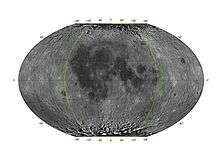Libration


In astronomy, libration is a perceived oscillating motion of orbiting bodies relative to each other, notably including the motion of the Moon relative to Earth, or of trojan asteroids relative to planets. Lunar libration is distinct from the slight changes in the Moon's visual size as seen from Earth. Although this appearance can also be described as an oscillating motion, libration is caused by actual changes in the physical distance of the Moon, because of its elliptical orbit around Earth.
Lunar libration
The Moon generally has one hemisphere facing the Earth, due to tidal locking. Therefore, humans' first view of the far side of the Moon resulted from lunar exploration on October 7, 1959. However, this simple picture is only approximately true: over time, slightly more than half (about 59%) of the Moon's surface is seen from Earth due to libration.[1]
Libration is manifested as a slow rocking back and forth of the Moon as viewed from Earth, permitting an observer to see slightly different halves of the surface at different times.
There are three types of lunar libration:
- Libration in longitude results from the eccentricity of the Moon's orbit around Earth; the Moon's rotation sometimes leads and sometimes lags its orbital position.
- Libration in latitude results from a slight inclination (about 5 degrees) between the Moon's axis of rotation and the normal to the plane of its orbit around Earth. Its origin is analogous to how the seasons arise from Earth's revolution about the Sun.
- Diurnal libration is a small daily oscillation due to the Earth's rotation, which carries an observer first to one side and then to the other side of the straight line joining Earth's and the Moon's centers, allowing the observer to look first around one side of the Moon and then around the other—because the observer is on the surface of the Earth, not at its center.
Trojan libration
In 1772 Lagrange's analyses determined that small bodies can stably share the same orbit as a planet if they remain near Lagrange points, which are 60° ahead of or behind the planet in its orbit. Such ‘trojan asteroids’ have been found co-orbiting with Earth, Jupiter, Mars, and Neptune. Trojan asteroids associated with Earth are difficult to observe in the visible spectrum, as their libration paths are such that they would be visible primarily in the daylight sky. In 2010, however, using infrared observation techniques, the asteroid 2010 TK7 was found to be a trojan companion of the Earth; it librates around the leading Lagrange point, L4, in a stable orbit.[2]
See also
References
- ↑ Spudis, Paul D. (2004). "Moon". World Book at NASA. Retrieved May 27, 2010.
- ↑ Connors, Martin; Paul Wiegert & Christian Veillet (28 July 2011). "Earth's Trojan asteroid". Nature. Nature. 475: 481–483. Bibcode:2011Natur.475..481C. doi:10.1038/nature10233. PMID 21796207. Retrieved 1 August 2011.
- J. D. Mulholland, E. C. Silverberg (1972). "Measurement of Physical Librations Using Laser Retroreflectors". Earth, Moon, and Planets. 4 (1-2): 155–159. Bibcode:1972Moon....4..155M. doi:10.1007/BF00562923.
- Moore, Sir Patrick (2003). Philip's Atlas of the Universe. Foreword by Sir Arnold Wolfendale. Philip's. ISBN 978-0-540-08707-5. OCLC 51966591.
External links
- Libration of the Moon from educational website From Stargazers to Starships
- Astronomy Picture of the Day: 2005 November 13 – time-lapse animation of moon through one complete cycle, hosted by NASA
- Libration: 2 years in 2 seconds – 24 full moon pictures taken over two years, compiled in an animation (linked on page) showing the Moon's libration and variations in apparent diameter
- Observing the Lunar Libration Zones
- Fine photographic show of lunar cycle and explanation of libration
